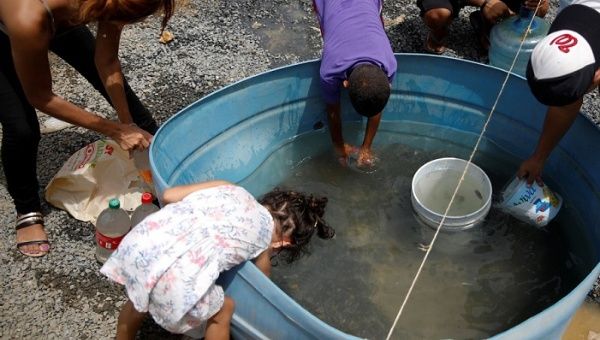Every 10 minutes or so, a truck or a van pulled up to the exposed spigot of an overgrown well, known as Maguayo #4, that sits not far from a bustling expressway and around the corner from a Krispy Kreme doughnut shop.
Fencing around the area had been torn open, and a red and white “Peligro” sign, warning of danger, lay hidden beneath debris and dense vegetation. One after another, people attached a hose to draw water for bathing, washing dishes and, in some cases, drinking. They filled buckets, jugs, soda bottles.
What many didn’t realize is that the well is one of nearly a dozen that are part of the Dorado Groundwater Contamination Superfund site — designated last year by the Environmental Protection Agency as among the nation’s most toxic sites.
Past testing here has shown the presence of tetrachloroethylene and trichloroethylene, solvents commonly used in industrial processes, which can cause health problems ranging from liver damage to increased risk of cancer. The EPA has yet to identify the cause of groundwater contamination in the wells, and local water systems no longer draw from them.
But the aftermath of Hurricane Maria has brought desperation in many forms. In this corner of the island, many residents still have no reliable source of water and search for access wherever they can.
It’s difficult to know just how many people have sought water from the Superfund site in the weeks since the Category 4 hurricane walloped Puerto Rico and crippled its infrastructure. The central water authority continues to depend on generators and some limited electricity-grid power to keep pumps working at plants across the island. As of Sunday, the government announced it had restored service to nearly 70 percent of customers.
But for the families who live in Dorado, nothing is yet flowing in their homes. In a single hour on Saturday, more than four families arrived at the unsecured Maguayo well to draw water. None was aware of the potential dangers. Several assumed the well was part of the “Supertubo” that carries water to greater San Juan, roughly 20 miles to the east.
In the late morning, EPA officials arrived on the scene just as a man and two children were topping off a 50-gallon container on the back of his pickup. Andres, who declined to give his last name, said he had been using the water for bathing and had no idea it might be contaminated.
The dozen officials, armed with kits, gloves and other materials to conduct tests, hastily reassembled the broken chain-link fence near the spigot and restored the “Danger” sign.
Recent local testing showed that contamination levels were below legal thresholds, but EPA spokesman Elias Rodriguez said the agency remains concerned about any residents drinking from wells that are part of the site. Officials said Sunday that data gathered in 2015 showed some wells were contaminated — exceeding standards for volatile organic chemicals — while others met drinking-water standards. The entire area was included in the Superfund site boundaries as a “precautionary measure” because groundwater contamination can move over time, the EPA said.
An agency statement said that the results of the bacteria portion of its testing should be available by midweek and that its chemical analysis should be completed by the end of next week.
Residents unwittingly drawing water from a Superfund site is merely one example of Puerto Rico’s dire lack of clean, reliable water. Government officials have said it could be months before power is fully restored across the island, which means that it could take nearly as long to get water flowing to all residents in need. National Guard troops and aid workers only recently began reaching the most far-flung communities with bottled water and water trucks.
The massive disruptions have forced residents to forgo the basics of modern plumbing and resort to any means available to fill containers. Along Highway 10, which cuts a jagged north-south route through the center of Puerto Rico, vehicles frequently line the road shoulders as drivers search for spring water flowing from craggy mountainsides.
In the mountainous municipality of Comerio, flooding from the hurricane left residents cut off from the central government and outside aid. So locals used plastic pipes to install a crude system to reroute spring water to a clearing where, one by one, people could shower. Elsewhere, residents have slogged regularly to creeks to fetch water and to bathe.
With the lack of reliable water has come increasing fear of disease.
Already, the island government has identified four suspected deaths as a result of leptospirosis, a bacterial infection spread by animal urine in the soil or groundwater. The deaths won’t be certified as “hurricane-related” unless the Centers for Disease Control and Prevention confirms lab samples indicating the victims became infected by drinking or having contact with contaminated water.
The health risks posed by water from the Maguayo well probably depend on the person, Rodriguez said. Any hazards might be more risky for vulnerable populations, such as elderly people or pregnant women.
Another EPA spokesman, Rusty Harris-Bishop, said government officials only recently learned that people were trying get water at Superfund sites. In one case, a local resident contacted the agency to request access to a well.
Harris-Bishop said the EPA began sending assessment teams late last week to evaluate hazardous waste sites in Dorado, Hormigas and San German. After surveying those locations and two others, the agency says it believes residents were able to access wells only at the Dorado site, although officials acknowledge they have no way of knowing how many people carted away water before the site was again secured on Saturday.
The EPA is working with the Federal Emergency Management Administration and the Army Corps of Engineers to ensure water trucks are reaching nearby neighborhoods. “We are sensitive to the suffering and needs of these communities,” Harris-Bishop said.




